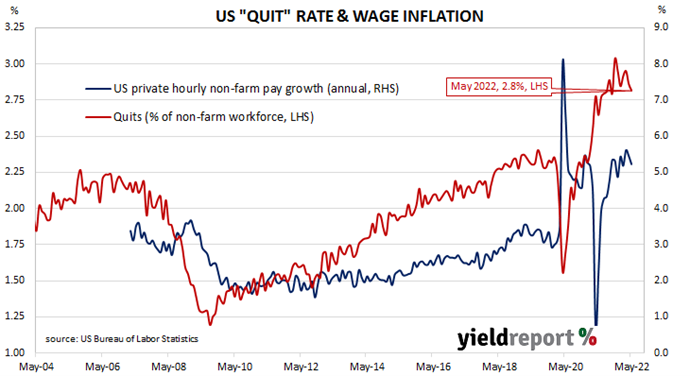Summary: US quit rate eases in May; indicative of “still uber-tight labour market”; quits, openings down, separations up; bond yields drop on hawkish FOMC minutes, expectations of higher rates firm.
The number of US employees who quit their jobs as a percentage of total employment increased slowly but steadily after the GFC. It peaked in March 2019 and then tracked sideways until virus containment measures were introduced in March 2020. The quit rate then plummeted as alternative employment opportunities rapidly dried up. Following the easing of US pandemic restrictions, it proceeded to recover back to its pre-pandemic rate in the third quarter of 2020 before trending higher through 2021.
Figures released as part of the most recent Job Openings and Labor Turnover Survey (JOLTS) report show the quit rate eased in May. 2.8% of the non-farm workforce left their jobs voluntarily, down from April’s figure of 2.9%. 57,000 fewer quits and an additional 390,000 people employed in the non-farm sector led to the decline.
Ray Attrill, NAB’s Head of FX Strategy within its FICC division, described the figures as “indicative of a still uber-tight labour market.”
US Treasury yields jumped on the day, especially at the short end of the curve, as markets digested the hawkish message emanating from the minutes of the FOMC’s June meeting. By the close of business, the 2-year Treasury bond yield had gained 18bps to 3.00%, the 10-year yield had added 13bps to 2.93% while the 30-year yield finished 9bps higher at 3.13%.
In terms of US Fed policy, expectations of higher federal funds rates over the next 12 months firmed. At the close of business, July contracts implied an effective federal funds rate of 1.675%, 10bps higher than the current spot rate while September contracts implied a rate of 2.445%. July 2023 futures contracts implied 3.215%, 164bps above the spot rate.
The fall in total quits was led by 33,000 fewer resignations in the “Real estate, rental and leasing” sector while the “Accommodation and food services” sector experienced the single largest rise, increasing by 35,000. Overall, the total number of quits for the month fell from April’s revised figure of 4.327 million to 4.270 million.
Total vacancies at the end of May decreased by 427,000, or 3.7%, from April’s revised figure of 11.681 million to 11.254 million. The fall was driven by a 325,000 drop in the “Professional and business services” sector as well as a 138,000 decrease in the “Durable Goods” sector. The “Retail trade” sector experienced the single largest increase, rising by 104,000. Overall, 12 out of 18 sectors experienced fewer job openings than in the previous month.
Total separations increased by 18,000, or 0.3%, from April’s revised figure of 5.965 million to 5.983 million. The modest rise was led by the “Real estate, rental and leasing” sector where there were 30,000 more separations than in April. Separations increased in 8 out of 18 sectors.
The “quit” rate time series produced by the JOLTS report is a leading indicator of US hourly pay. As wages account for around 55% of a product’s or service’s price in the US, wage inflation and overall inflation rates tend to be closely related. Former Federal Reserve chief and current Treasury Secretary Janet Yellen was known to pay close attention to it.


